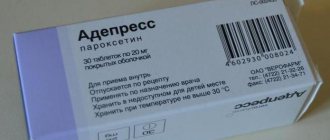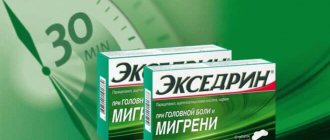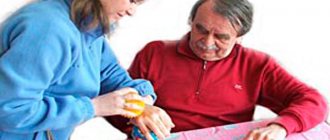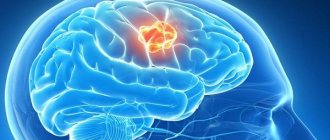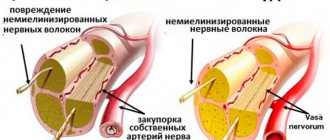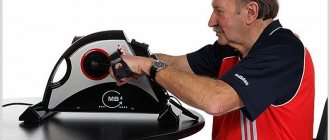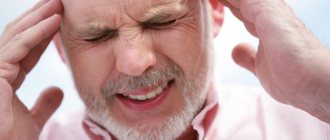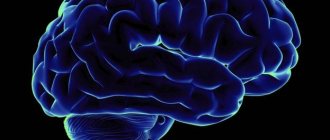Author's rating
Author of the article
Smirnova Olga Leonidovna
Neurologist, education: First Moscow State Medical University named after I.M. Sechenov. Work experience 20 years.
Articles written
94
A stroke is an acute disorder of cerebral circulation. There are ischemic and hemorrhagic pathological processes. In the first case, the culprit of the circulatory disorder is a blood clot. In the second, there is perforation of the vessel walls.
The goal of drug therapy for such disorders is to minimize damage to nervous tissue, prevent the development of neurological complications and death. Medicines for stroke are selected individually, taking into account the type of pathology, the age of the patient, and the degree of damage to brain tissue.
Drug therapy, according to the protocols and recommendations of the World Health Organization, is mandatory for cerebrovascular accidents of any origin.
Treatment effectiveness
Drugs for the treatment of stroke are selected individually, taking into account the type of pathology. The effectiveness of medications is assessed based on the patient's condition.
Stroke medications must meet the following requirements:
- Effective relief of disease manifestations.
- Localization of the pathology focus, impossibility of expanding the affected area.
- Restoration of damaged tissues and lost functions.
If the examination showed the presence of ischemia - thrombosis of the vessel - then the effectiveness of drug treatment can be discussed only after the patency of the vessel is restored. In case of hemorrhagic cerebral stroke - after stopping the bleeding. In both cases, surgical intervention cannot be ruled out.
Medicines for cerebral stroke are divided into first aid medicines, active therapy and medicines prescribed during the rehabilitation period. Therefore, the term “stroke cure” does not exist; treatment is carried out comprehensively.
How to restore memory
One of the primary goals of recovery after a stroke is improving memory. You need to start working on this immediately after discharge. As soon as the threat of death and cerebral edema has been eliminated, you can begin to work on memory.
First of all, the affected neurons are supported with the help of nootropic drugs. They are administered intravenously. These products have the properties of improving cerebral circulation and memory. They need to be taken at home, but in tablet form. Use such medications for at least three months, as they act very slowly. After this, take a break and repeat the course.
In addition to medications, people seek help from functional restorative methods. It is based on constant training of the ability to remember. This process can continue for months, even years.
The patient must gradually memorize numbers, phrases, memorize poems, first short, then longer. Board games and other entertainment that allow you to escape from the world around you and concentrate on your actions and specific objects are also suitable for improving memory.
First aid
If you suspect a cerebrovascular accident, it is prohibited to give or take any medications yourself. Even painkillers. This will blur the picture of the disease.
After making a preliminary diagnosis, ambulance specialists use the following medications after a stroke:
- Diuretics to prevent swelling of brain tissue. When blood vessels are damaged, tissue swelling begins. An increase in brain volume causes it to begin to compress the brain stem. It is in this part that the respiratory center and the area responsible for contraction of the heart muscle are located. Swelling of this area is fatal.
- Nootropics - to improve the nutrition of nervous tissue, but to reduce the oxygen demand of cells. The use of drugs in this group significantly increases the chances of survival and return to a full life.
- Hemostatics are drugs aimed at stopping bleeding. They do not form fibrin clots, so they can be used for strokes.
- Blood substitutes to compensate for the effects of diuretics.
- Thrombolytics - indicated for ischemic cerebrovascular accidents. The components of the drugs have a resolving effect on fibrin clots. Contraindicated in hemorrhagic hemorrhage and prescribed based on tomography results.
Are IVs given after a stroke?
Droppers are the most effective method of administering medications. But some patients are skeptical about them.
Positive properties of administering drugs through IVs:
- The effect of the drugs comes faster. If the drug is taken orally, the effect will have to wait longer.
- The drug is administered smoothly, which is very important, because In case of a stroke, medications cannot be suddenly introduced into the body.
- Droppers are a current method of administering medications for people who have had a stroke, because... in the first days after the illness they are unable to swallow.
- When the medicine is administered through droppers, more active substance enters the body than when administered orally. When swallowed, the drug enters the liver barrier, and some of the beneficial substances remain in the intestines. During IV drips, beneficial substances reach the right place faster.
- When frequently administering a large number of drugs, it is more convenient to use droppers.
In addition to the advantages, the method of administering drugs through droppers has significant disadvantages:
- If a patient has an allergy, it is almost impossible to quickly change the amount of the drug in the body. When swallowing the product, gastric lavage helps get rid of unpleasant symptoms.
- If the IV is inserted incorrectly, an infection may enter the body through the puncture site and the vein may become inflamed.
- If the catheter is inserted incorrectly, the drug will not enter the body, but into its tissues. This can lead to the development of inflammation.
- If the IV is installed incorrectly, air may enter the patient's vein and an air embolism may develop.
List of medications for recovery
In the treatment of cerebral stroke, drugs that are described in the protocols of the World Health Organization have proven themselves to be effective.
List of tablet and injection forms:
- Ceraxon - the drug improves metabolic processes in brain tissue, reduces swelling. While taking it, the regression of mental activity, speech, and cognitive functions is inhibited. The medication for stroke is indicated to be administered intravenously or by drip. The drug is prescribed both after a stroke in the acute period and during rehabilitation.
- Gliatilin is a neuroprotector. Protects cells and promotes recovery from brain injuries. Indicated for acute and subacute stages of ischemic pathologies. For hemorrhagic stroke, it is used only during the rehabilitation period. How to take the drug depends on the type of cerebrovascular accident. In acute ischemia, drip administration is indicated, followed by switching to tablets.
- Furosemide is a diuretic drug. A medication is used to reduce brain swelling. In case of cerebrovascular accident, intravenous or intramuscular injections are prescribed. Furosemide flushes potassium from the body. Therefore, it is necessary to prescribe additional medications containing this microelement.
- Piracetam is a drug for improving nutrition and tissue metabolism for the brain. Belongs to the group of nootropics. In the acute phase of the disease, it is administered dropwise with a glucose solution. After a stroke, for recovery and prevention of relapse, they switch to intramuscular administration of a nootropic.
- Aminocaproic acid is a hemostatic agent. It is a powerful hemostatic agent and in case of hemorrhagic stroke it is administered at the stage of transporting the patient to a medical institution.
- Reopoliglucin is a blood substitute. Prescribed for circulatory disorders. Administered by drip.
- Heparin, Warfarin are drugs that prevent blood from clotting. In this case, vitamin K, which is involved in the formation of a fibrin clot, is blocked. The drugs are prescribed for ischemic stroke during the acute period.
Additionally, painkillers are indicated at the doctor's discretion. Mild antidepressants are indicated. In some cases, drug therapy is carried out continuously, for life.
Basic antihypertensive therapy
The goal of antihypertensive therapy for ischemic stroke is to maintain an optimal level of cerebral blood flow in the most vulnerable areas of the brain. Doctors at the Yusupov Hospital take an individual approach to prescribing medications that lower blood pressure to patients with ischemic stroke. In the intensive care unit, patients undergo dynamic monitoring of: blood pressure, heart rate, electrocardiogram parameters, state of central hemodynamics, linear blood flow velocity in brain tissue
In the event of a sharp increase in blood pressure after development, it is carefully reduced by approximately 10-15% with careful monitoring of the possible appearance of new neurological disorders in the patient. A rapid decrease in blood pressure when taking antihypertensive drugs in some cases leads to disruption of the blood supply to the ischemic area of the brain with a subsequent increase in neurological deficit.
In order to correct significant disorders of the cardiovascular system caused by a sharp rise in blood pressure during ischemic stroke, doctors at the Yusupov Hospital use the following antihypertensive drugs:
With a pronounced decrease in blood pressure, patients with ischemic stroke in the Yusupov Hospital are administered the most effective drugs:
- dopamine (dopamine, dopmin);
- prednisolone hemisuccinate (solu-decortin);
- Gutron.
When prescribing differentiated treatment for ischemic stroke, doctors at the neurology clinic select specific drugs taking into account the leading mechanism of development of the disease: stroke due to damage to large arteries, cardioembolic, lacunar and unidentified or mixed nature. First, neurologists determine the stroke subtype based on the results of a comprehensive clinical and instrumental examination, after which they prescribe differentiated therapy.
Make an appointment with a neurologist at the Yusupov Hospital by calling. Professors and doctors of the highest category have the knowledge and experience necessary to select the most effective ones among the many drugs for the treatment of ischemic stroke. The treatment regimen is selected individually, after examination using modern diagnostic methods.
Source: yusupovs.com
How can you replace your usual medications?
If the drugs from the standard treatment regimen or drugs for recovery during the rehabilitation period for some reason cannot be purchased, or there are contraindications for use, then you need to take tablet or injectable forms with similar effects.
What medications can the doctor prescribe:
- Actovegin is a drug of animal origin, obtained from the blood of cattle. The drug improves the absorption of oxygen by cells, reduces the effects of hypoxia, which helps restore brain tissue after hemorrhage or vessel thrombosis. The drug is available in tablet and injection forms. In the acute period, drip administration is indicated; in the rehabilitation period, the patient is transferred to oral administration of the drug.
- Vinpocetine – improves blood supply to brain tissue and glucose absorption. This drug showed the best results in ischemic stroke. The drug is used in the acute period of cerebrovascular accident. Drip administration with a gradual increase in the dosage of Vinpocetine is indicated.
During the recovery period, dosages are reduced and the patient is transferred to tablet forms.
- Pentoxifylline – has a mild vasodilator effect, which makes it possible to use it for cerebral vascular ischemia. In the acute period, intravenous and intra-arterial administration is indicated. Next, according to indications, switch to oral forms.
- Sodium chloride is a solution of table salt in a certain concentration, similar in composition to plasma. Sodium chloride helps improve the absorption of medications, reduces tissue swelling, and is used as a solvent and transport medium for other medications. It is administered by drip in both acute and rehabilitation periods.
- Phenibut – this drug belongs to the “nootropics” class. Improves tissue trophism. While taking the drug, higher nervous functions improve - speech, thinking, memory. Additionally, the product has a sedative effect and helps reduce anxiety and anxiety. Phenibut must be taken orally, so it is prescribed during the rehabilitation period.
- Pantogam is a nootropic drug. Increases the resistance of brain tissue to a lack of oxygen and nutrients. It is a mild sedative and improves higher nervous functions – speech, thinking. It is available in tablet form and is prescribed after the acute period has stopped.
- Cyclomethiazide is a diuretic. Prescribed for intolerance to Furosemide. It flushes chlorine-containing compounds from the body, so it is used simultaneously with Aspartame.
- Decylate is an analogue of Valfarin and Heparin. The drug promotes the production of fibrin, which makes it possible to use it for hemorrhagic hemorrhage in brain tissue. Decylate is administered exclusively intravenously.
- Methyldopa - lowers blood pressure, reduces the degree of vascular resistance to blood flow. This allows the drug to be used for various cerebral circulatory disorders associated with increased blood pressure.
Stroke prevention - general recommendations
You can avoid vascular accident and its severe consequences using the following measures:
- monitor blood pressure levels, as well as cholesterol levels in the blood and control them with lifestyle changes and medications recommended by a doctor;
- give preference to healthy habits and lifestyle, observe sleep and work patterns;
- contribute to the normalization of intracerebral blood flow through physical exercise (walking in the fresh air, walking, swimming, exercises for the spine, etc.) and medications prescribed by a specialist;
- pay attention to the prevention of thrombosis Thrombosis
A disease in which blood clots form inside blood vessels, mainly peripheral ones. (active lifestyle, drinking regimen, antiplatelet drugs in the dose prescribed by the doctor, etc.); - increasing the trophism of nervous tissue and the resistance of brain cells to hypoxia Hypoxia
Decreased oxygen content in the body or individual organs and tissues.
and ischemia Ischemia
Local decrease in blood supply due to narrowing or blockage of a vessel and disruption of the supply of nutrients and oxygen, leading to tissue and organ damage.
Most of these recommendations help reduce the risk of stroke, but stroke prevention without medications that are designed to directly protect nerve tissue will not be complete. Therefore, in addition to following general recommendations, you can ensure effective protection of brain cells with the help of such a neuroprotector Neuroprotectors
Medicines that prevent damage to nerve cells in the brain from adverse effects.
Their influence is aimed at eliminating or reducing disturbances in nerve cells. and neurometabolics Neurometabolics
A drug intended to influence higher brain functions. Improves memory, stimulates mental activity, increases and facilitates the learning process, like “Semax 0.1%”.
Dietary supplements for stroke
Bioactive supplements are drugs with unproven effects. Unlike the drugs of official medicine, dietary supplements have not undergone clinical trials with the participation of volunteers. These funds lack medical statistics.
Therefore, in the acute period, such drugs are completely prohibited. You should not try to replace medications prescribed by your doctor with dietary supplements. During the rehabilitation period, the use of dietary supplements should be discussed with the neurologist who is caring for the patient. The same recommendation is relevant for preventive use.
Stroke therapy is an individual matter. Sometimes doctors have to try several different drugs, even complete analogues, in order for the patient’s condition to improve.
Recovery from circulatory disorders in brain tissue is a long, and in some cases, lifelong process. And the quality of his life and life itself depend on how carefully the patient follows the doctor’s orders.
There is no need to search on the Internet for “stroke injections” or “what medications and what to drink.” The main thing you must do is deliver the patient to a medical facility. And the best prevention of cerebrovascular accidents will be giving up bad habits, normalizing nutrition and minimal physical activity.
Drugs for stabilization
When a stroke is diagnosed, treatment with drugs that stabilize blood pressure is continued long enough to prevent a relapse of the disease; antidepressants are also prescribed without fail.
They are necessary not only to eliminate the feeling of fear of a new attack, but also to eliminate the negative symptoms experienced by patients with various disorders of brain activity. Antidepressants help to successfully overcome various anxieties and doubts, which has a beneficial effect on the general well-being of patients.
In the same way, you will need to take nootropic drugs and various drugs that improve brain function for a long time. It is imperative to follow a special diet that minimizes the risk of relapse.
In case of stroke, treatment with drugs that are angioprotectors is always prescribed; their effectiveness in restoring impaired microcirculation during the pathological process caused by compression of brain tissue has been proven more than once.
They have proven themselves to be effective when administered simultaneously with enzymes and vitamins, improving microcirculation and increasing platelet activity.
